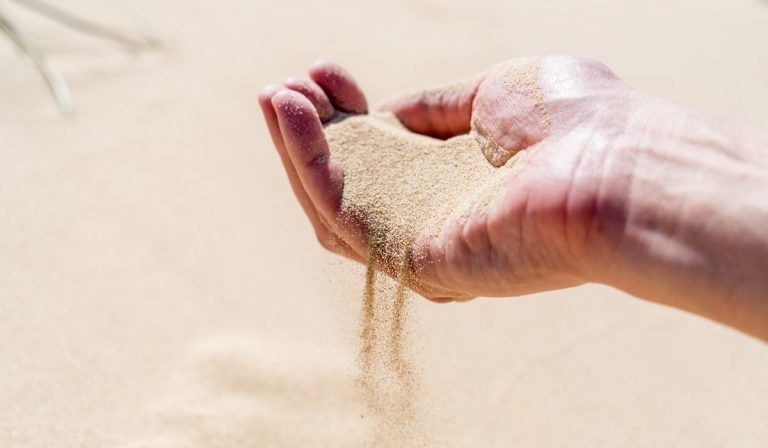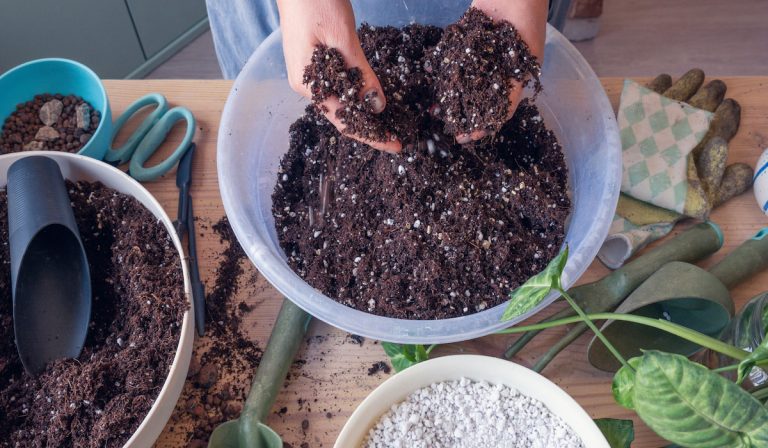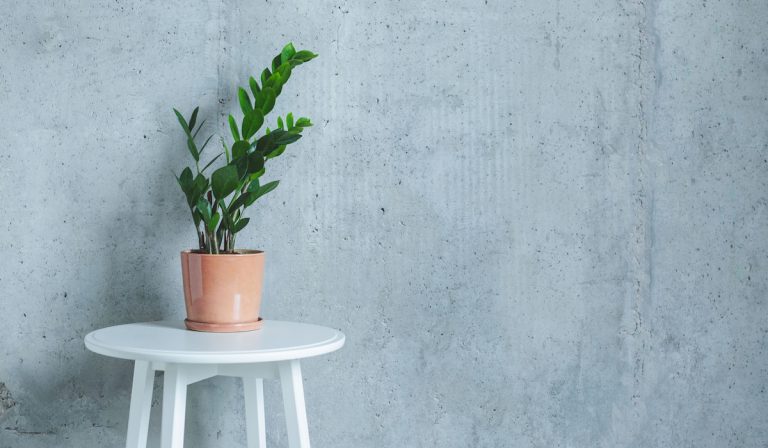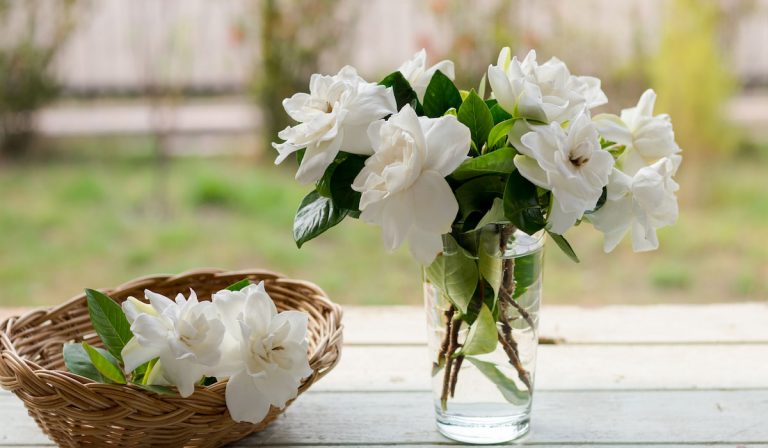15 Types of Indoor Plants With Big Leaves
When we talk about interior design, most people assume that lighting, the color of your couches, and the arrangement of your furniture, are enough to make your house a lovely sanctuary.
But there is one more thing that will increase the interior of your house without causing too much of a dent in your pocket.
It is by adding indoor plants. Indoor plants come in many different species, shapes, and sizes.
Some people prefer houseplants with flowers and fruits. Others want some that provide shade to keep a cooler temperature inside their house. I
f you belong to the second group of people, having indoor plants with big leaves is certainly the best option.
Let’s take a look at these 17 indoor plants with big leaves that will help to green-up and brighten your living space:
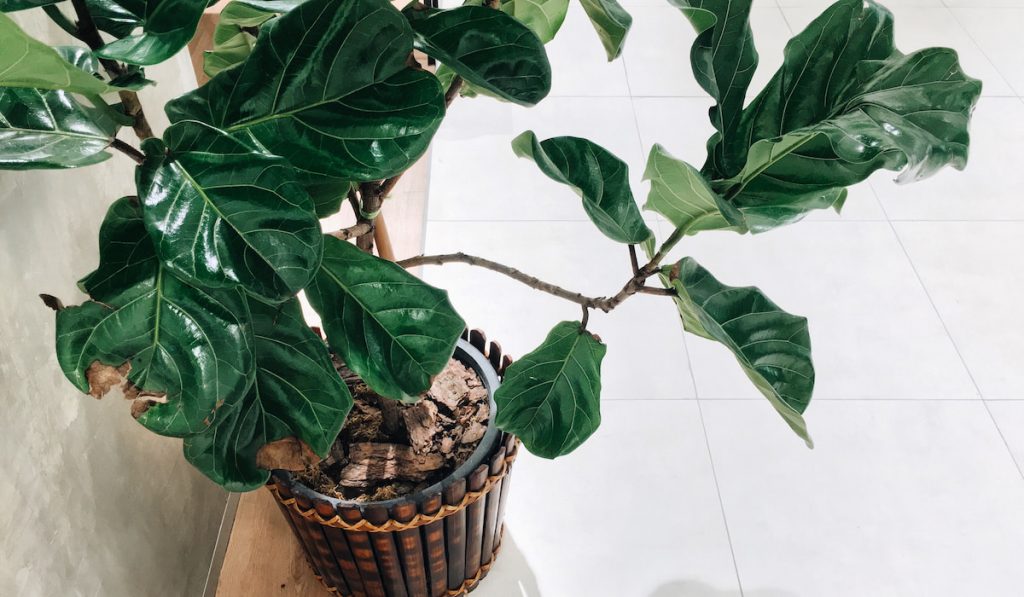
Table of Contents
1. Fiddle Leaf Fig
Scientifically known as Ficus lyrata, the fiddle leaf fig is native to western Africa where it naturally grows in the lowland rainforest.
The fiddle has big leaves, shiny foliage, and can grow up to six feet tall.
This plant loves sunlight, a humid environment, and enough water to nourish it. Its violin-shaped leaves will certainly make your interior designs more vibrant.
One of the best things about having this plant in your house is that they thrive on direct or indirect sunlight.
Positioning them near your window or at the corner of your room will be fine as long as they get some exposure to sunlight.
2. Cast Iron Plant
The Cast Iron plant, also known as Aspidistra elatior, is a big leaf indoor plant with dark green foliage.
It is native to China and one of the members of the lily family. Its big leaves can grow up to two feet long and four inches wide.
Having this plant in your house is easy compared to other indoor plants.
It doesn’t require much attention and is not time-consuming like any other plants.
It also can thrive without much sunlight, water, humidity, changing temperature, and most of all, it is self-sufficient.
But like all plants, they still need some water and sunlight from time to time.
Rest assured, raising this plant in your house won’t be much of a hassle. Plus, insects are not attracted to it which contributes to its low chance of having any diseases.
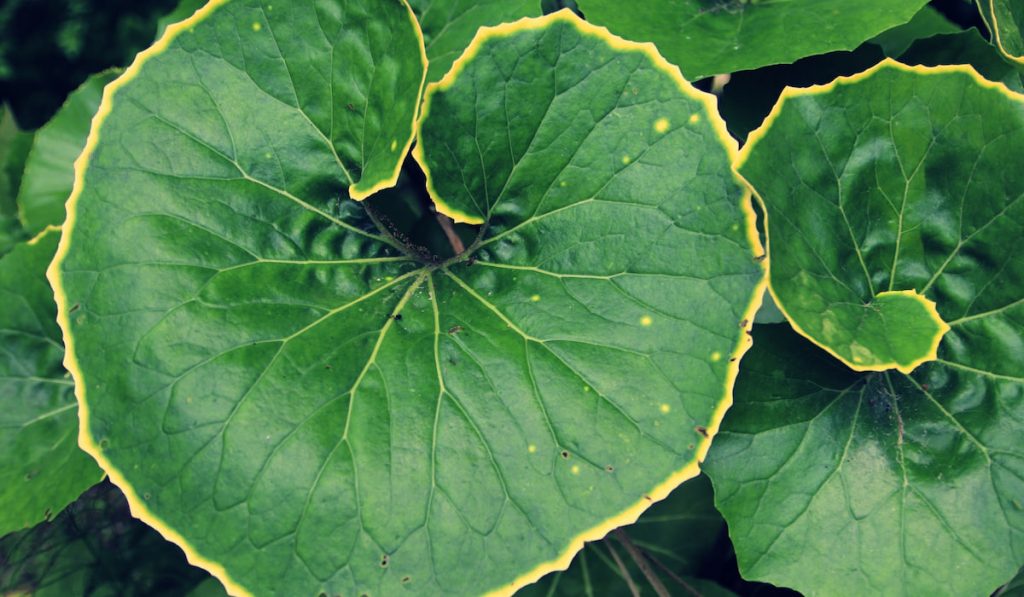
3. Giant Leopard Plant
The giant leopard plant is native to the wet, moist streambanks and meadows in Japan.
Scientifically named Farfugium japunicum var. giganteum, this perrenial plant has thick and shiny pelargonium-shaped leaves that are large and waxy.
Its dark green leaves can grow up to 18 inches wide. Most giant leopard plants possess white or yellow markings on their leaves and daisy-like yellow flowers.
This plant is most suitable to be kept indoors or at the corner of the room where sunlight does not reach.
This is because they grow best with partial to low exposure to sunlight and damp soil.
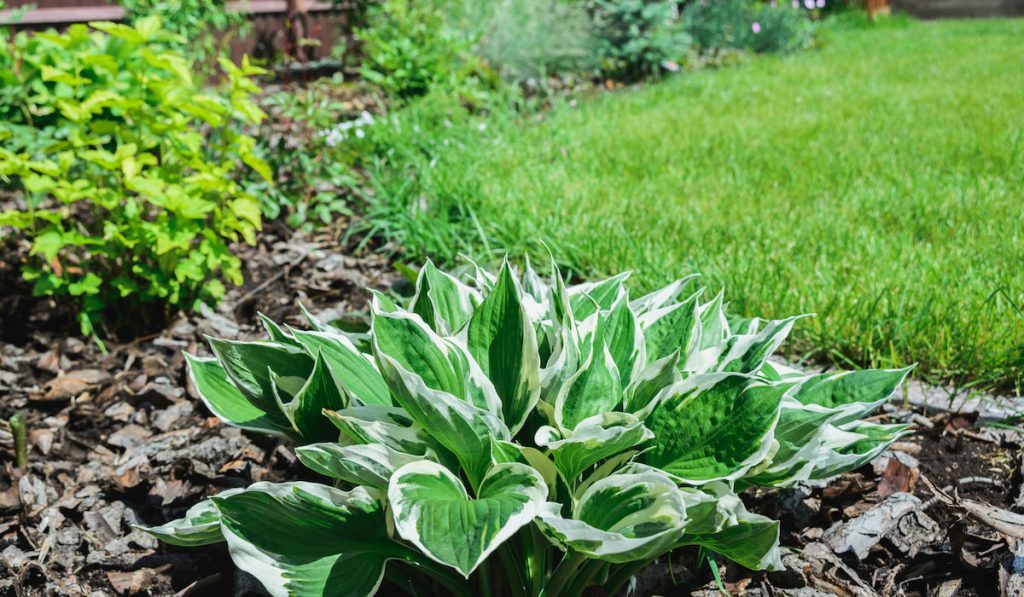
4. Hosta Plant
The Hosta plant is native to Asia, specifically Japan, Korea, and China.
Also known as plantain lily, they thrive in open green lands, moist forests, and along rivers and streambanks.
This hardy, clump-forming perennial plant is well-known for the beautiful foliage that comes in pale yellow, blue-greens, with many variegated forms on it.
Different varieties of hostas grow at different paces. Some mature quickly between three to five years but larger ones can take up to seven years.
When growing Hosta indoors, it is best to use moist and fertile soil with exposure to partial sunlight or full shade.
The best thing about having Hosta as your indoor plant is that it could grow white or purple flowers in summer.
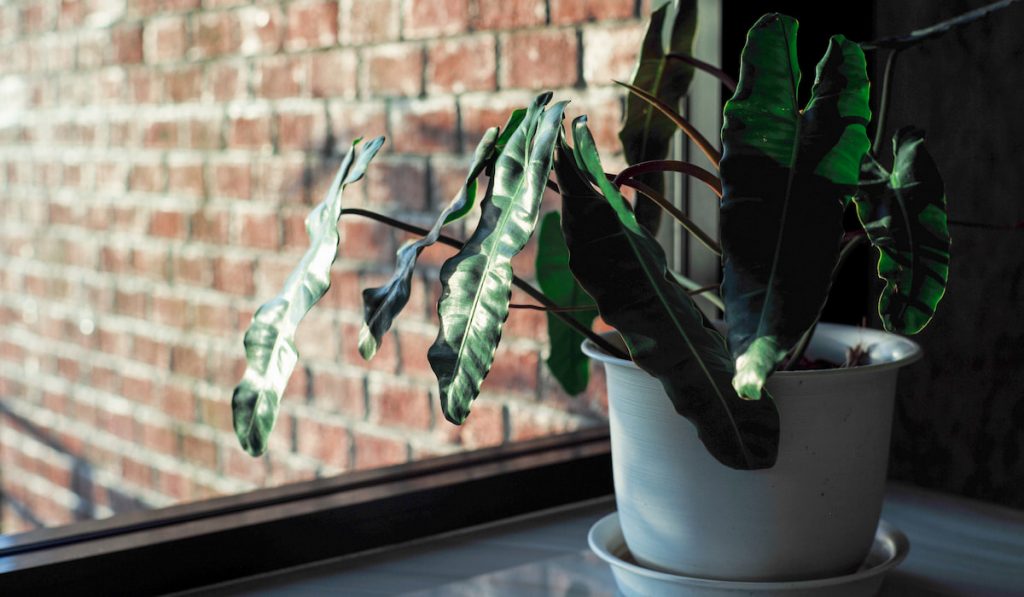
5. Elephant Ear Plant
Like its name, the elephant ear plant or Colocasia is a tropical perennial plant with heart-shaped large leaves that can grow up to 35 inches wide.
This plant originated in Southeast Asia, Oceania, and South America. Its foliage colors vary from green, to white-green variegated, or purplish black.
The elephant ear plant can be divided into three genera; Colocasia, Alocasia, and Xanthosoma.
It also grows quickly and can mature within two months.
Growing this plant indoors will bring a tropical atmosphere to your room while simultaneously regulating the temperature inside your house.
Be sure to plant it in a large pot and keep it away from windows and open spaces.
Although this plant can be exposed to direct sunlight, it performs best with partial sunlight. This will prevent its leaves from getting sunburn.
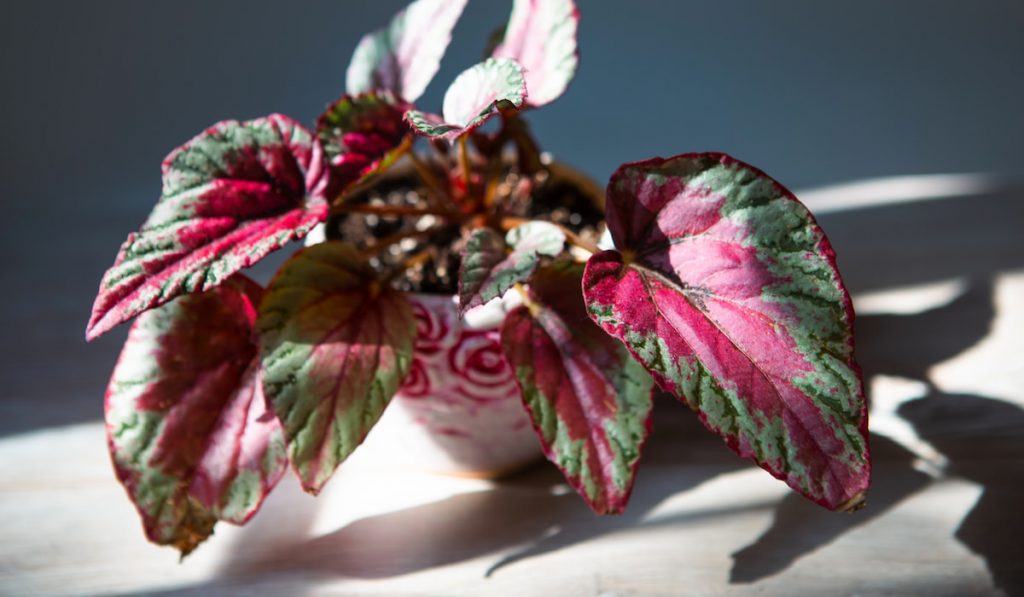
6. Rex Begonia
Also known as Begonia rex-colturom, this indoor plant is native to tropical regions like southern China, northeastern India, and Vietnam.
Rex begonia is a tropical plant with unique leaf shapes, markings, and colors. Its leaves come in many different shapes like hearts, seashell swirls, ivy-like shapes, and many more.
The color of its foliage also varies from red, green, pink, and silver, to black.
It grows up to 18 inches wide with a small pink flower that blooms during summer. Growing Rex Begonia indoors will add more color to the atmosphere inside your house.
But this plant needs quite a lot of attention including the way you place it in your house, the moisture level of the soil, humidity, and more importantly, the temperature inside the house.
Using fertilizer is beneficial to accelerate its growth while providing the soil with enough nutrients.
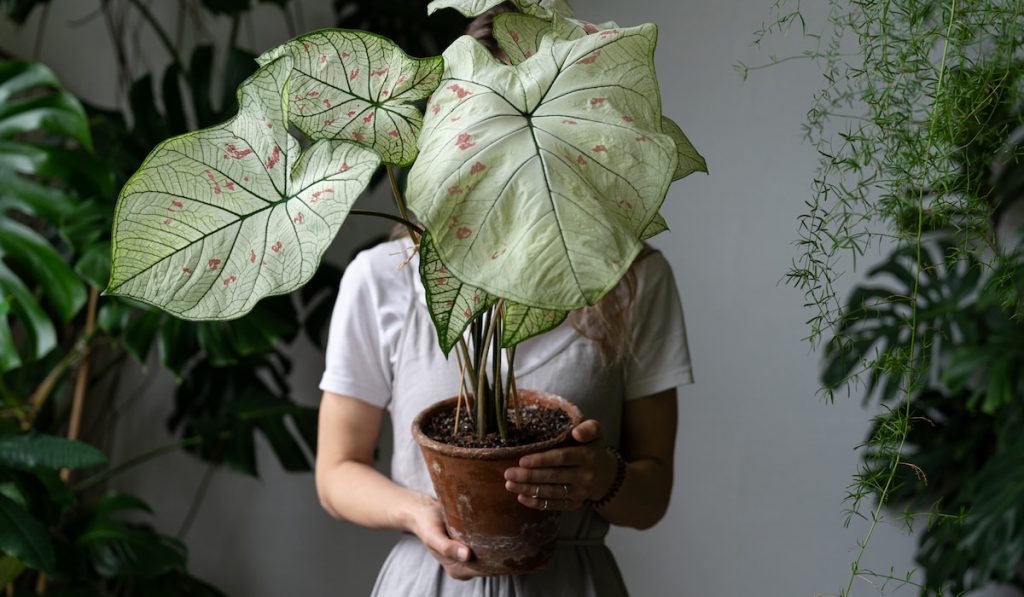
7. Caladium Plant
The Caladium plant is a tuberous tropical perennial plant that is native to South and Central America.
Also known as the angel wings and belonging in the same family as elephant ears, it has large, arrow-shaped, thin leaves with different markings and colors like red, green, pink, and white.
Caladium can be divided into two types of leaf: the fancy leaf (which is a large heart-shaped leaf that grows more than one foot long) and the strap leaf (with arrow-like, lance-shape foliage that withstands cold temperatures).
To grow this plant indoors, a high humidity environment and nutrient-rich soil are needed to keep it healthy.
If you have pets, keep them away from this plant due to the toxic properties found in its leaves.
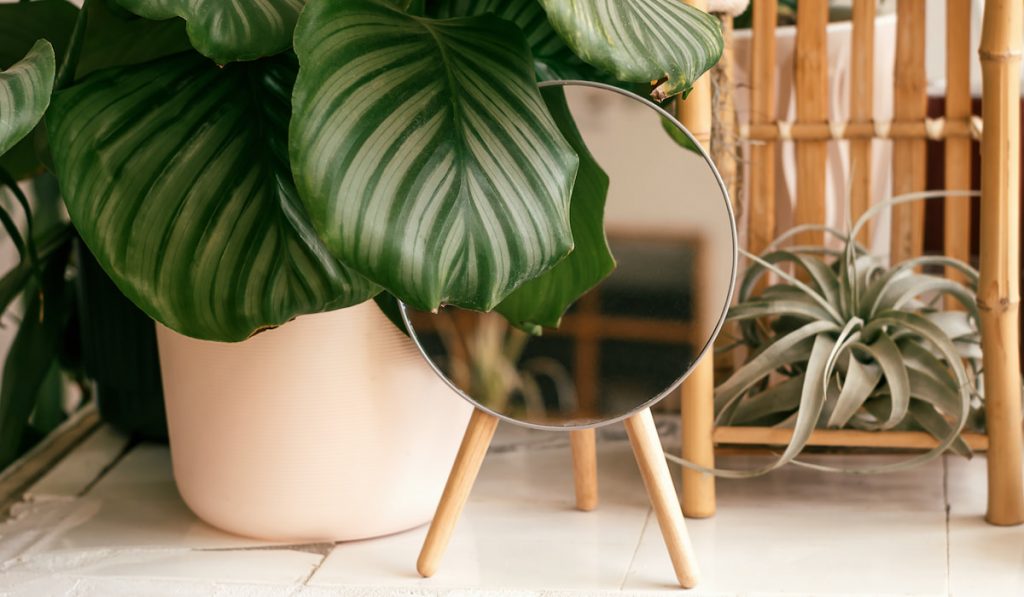
8. Calathea Orbifolia
This tropical plant is one of the most famous indoor plants that is well-known for its large and beautiful glossy leaves.
Calathea Orbifolia is native to Bolivia.
It grows up to three feet in height and its leaves reach a width of around 12 inches.
Pale silver-green markings are found on its leaves, which is similar to the color of the underleaf.
This plant needs high humidity, warm temperature, and peat-based soil to grow at an optimal level. It also can’t be exposed to direct sunlight to prevent the leaves from fading and losing their markings.
However, unlike some plants, Calathea Orbifolia is non-toxic and safe for humans and animals.
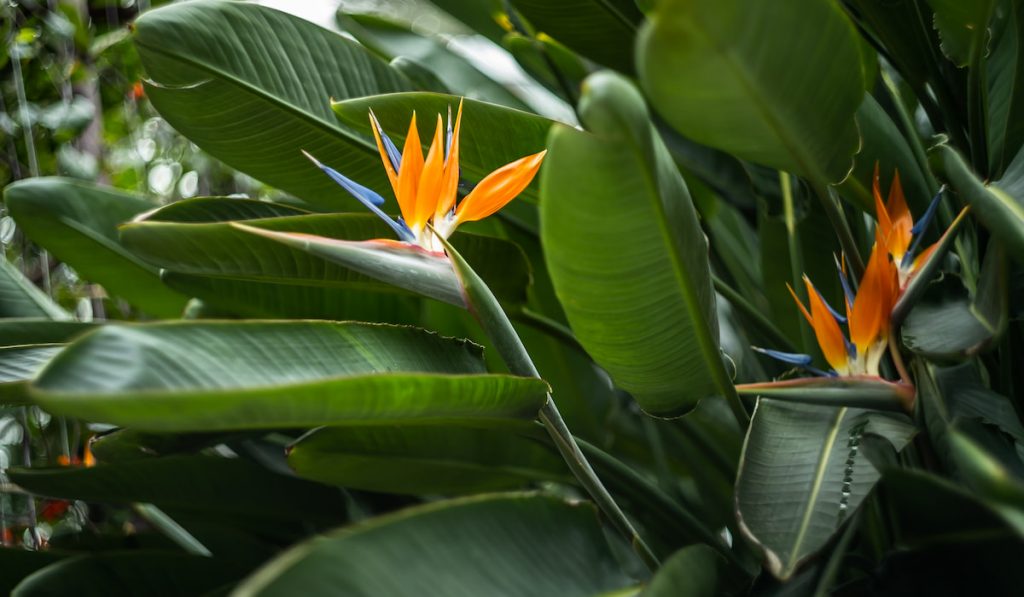
9. Birds Of Paradise Plant
Birds Of Paradise plant, also known as Strelitzia Reginae or crane flower, is one of the exquisite plants that are native to South Africa.
This tropical plant can be recognized by its glossy fan-shaped leaves and orange or white flowers that resemble the shape of a flying bird.
It grows up to six feet tall while its leaves vary in sizes from 12 to 18 inches long. It generally needs between three to five years before the flowers bloom.
When growing the crane flower indoors, it is best to place it near windows with direct sunlight.
Also, keeping this plant in small rooms might not be the best option because of its size. Other than that, this plant is easy to grow with enough water and fertilizer in the soil.
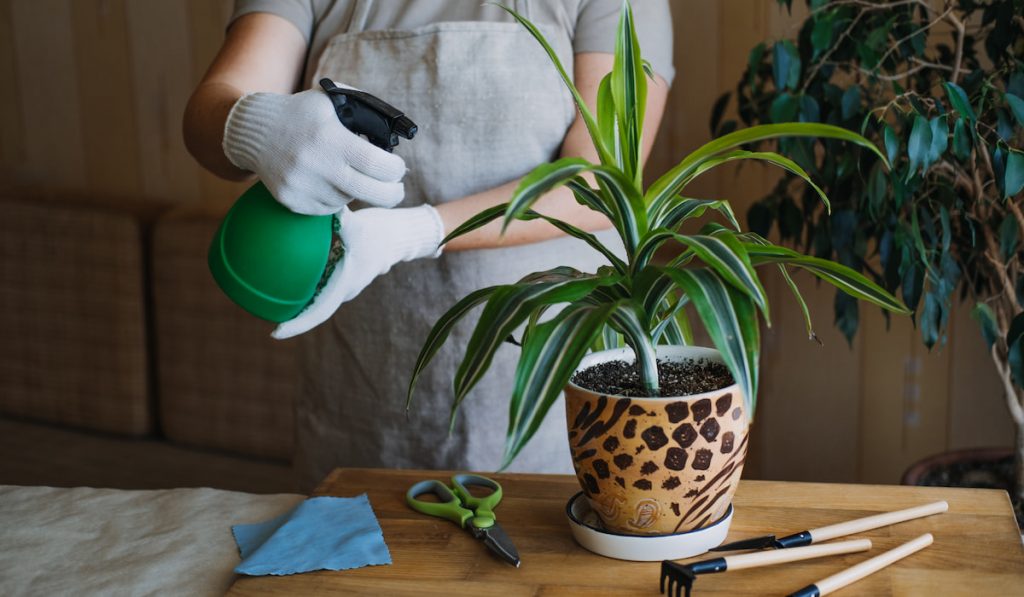
10. Corn Plant
The corn plant is a tree-like plant with narrow, dark green leaves that is native to Africa.
Also known as Dracaena fragrans ‘Massangeana’or false palms, this houseplant can grow up to six feet tall in a pot or a container.
Keeping this plant indoors is quite easy as it doesn’t require extreme care.
But be sure to not overwater or overfertilize the soil. In some cases, a healthy mature corn plant blooms white or yellow flowers. But this phenomenon frequently happens when it grows outdoors.
Also, be sure to not expose this plant to too much direct sunlight to prevent any brown scorch marks on its leaves.
One of the good things about growing a corn plant indoor is that it naturally cleans the air and remove air toxins like ammonia, formaldehyde, toluene, and xylene.
If you have pets like cats or dogs, this plant might be toxic for them. So, keep your animals away from it.
11. Ruffled Fan Palm
Also known as Licuala Grandis, ruffled fan palm is native to Vanuatu Island, located 500 miles west of Fiji in the Pacific Ocean.
This plant has a circular, fan-like, undivided dark green leaf that could grow to about 2.5 inches centimeters wide.
When mature, it reaches a height of 32 feet tall. But if you’re trying to grow this plant in a pot, it will only grow up to six feet tall.
Ruffled pan palm is easy to grow indoors. It only needs partial or complete shade but can also withstand direct sunlight.
This plant grows best in cooler climates and as it matures, it tolerates changing temperature.
To sustain their health growth rate, be sure to keep the soil moist and fertilized.
One of the best things about having this big leaved plant as your indoor houseplant is that when placing the ruffled fan near windows, it provides shade and regulates the temperature inside your house.

12. Monstera Deliciosa
Monstera Delicious is widely known by its other name, the Swiss-cheese plant.
This hardy tropical plant is native to Southern Mexico and Panama and distinctively recognized by its leaf-holes called fenestrations.
The holes found on its leaves help this plant in capturing the sun fleck on the forest floor while simultaneously increasing the spread of the leaf. The leaves could grow up to two feet wide.
When growing the Swiss cheese plant indoors, it is best to place it in a large room.
Avoid putting this plant in tight corners. Although it can withstand direct sunlight, this plant grows well under bright to medium indirect sunlight.
Like any other plant, it also needs regular watering and nutrient-rich fertilizers in the soil.
13. Philodendron Gloriosum
Philodendron Gloriosum is a creeper plant that is native to countries like Colombia, Mexico, Brazil, Venezuela, as well as Central America.
It has dark green, heart-shaped leaves, with velvet-like texture and cream-colored vines.
It grows up to 36 inches tall in the wild, but not when you’re growing it indoors.
Philodendron Gloriosum grows well with bright indirect sunlight.
The best place to put this plant is near the window or a tight corner that has some exposure to sunlight.
Regular watering is also essential but be sure not to pour too much water to prevent the soil from getting soggy.
This plant enjoys high humidity. So misting Philodendron Gloriosum at least once every two days is better to keep the humidity at an optimum level.
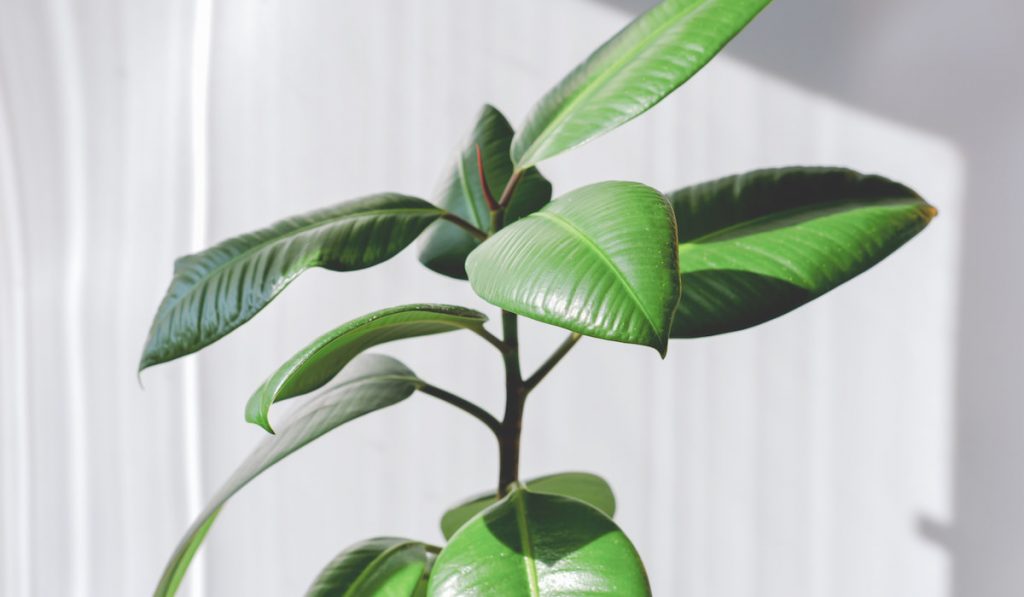
14. Rubber Plant
Originated in southern China, Southeast China, and Indonesia, the rubber plant is a popular houseplant with waxy leaves and reddish-brown underleaves.
Also known as Ficus elastica, this medium-sized plant can grow up to 50 feet tall in the wild.
But growing it in a small pot will restrict its growth thus making it one of the best choices for indoor plants.
The rubber plant grows well with bright or indirect sunlight. The best place to put it in your house is near windows with curtains or any shaded corner.
This is because any direct sunlight can scorch the leaves. Aside from sunlight, the right amount of water is also essential to nourish this plant.
In the winter, during its dormant season, keep the soil moist but not to the point where it gets soggy.
The rubber sap from this plant might cause itchiness or irritation to humans or animals. Be sure to wash your hands after holding or handling this plant.
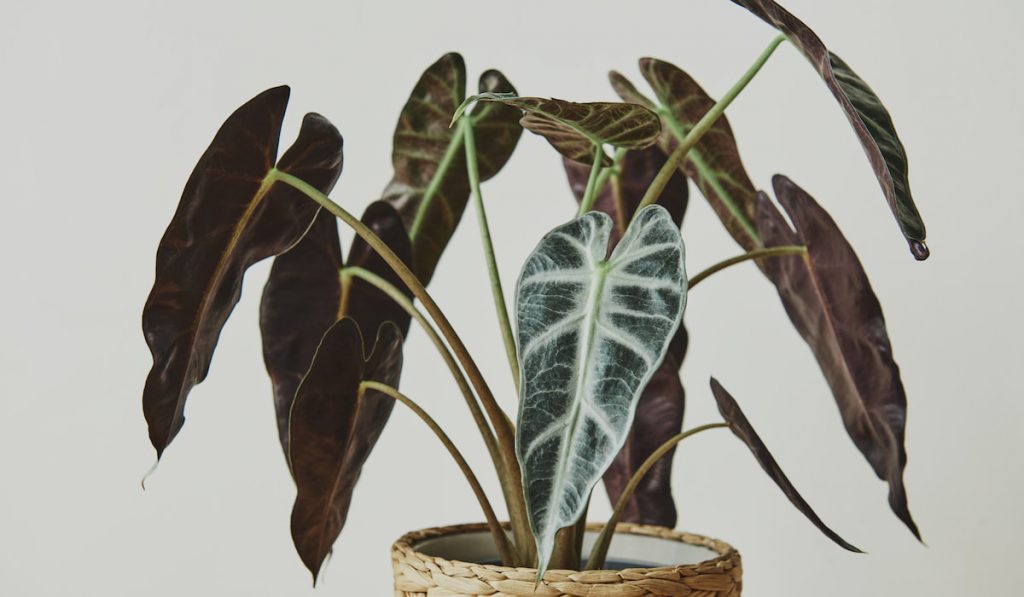
15. African Mask Plant
Also known as Alocasia x amazonica or Kris plant, the African mask plant belongs in the same family as the elephant’s ear plant.
It is native to Southeast Asia and grows up to six feet tall. This perennial plant has leaf shapes that vary from wide hearts to slim arrowheads.
The leaves also have glossy, wax-like properties with white or light-green veins. This unique houseplant is well-known for its beautiful foliage but it rarely blooms.
Growing this plant indoors might take some work but it’s totally worth it. For instance, it needs a warm and high humidity environment that is similar to its natural outdoor environment.
Expose it to plenty of bright indirect sunlight. Also, misting this plant regularly is always good to keep the leaves healthy while maintaining the humidity at an optimum level.
Between two and four weeks, throw some fertilizers on the soil to sustain the nutrient level.
Finally, keep this plant away from your pets. This is because its leaves contain a chemical that might be toxic when ingested.
Final Thought
Choosing the right houseplant that suits your need and the type of house you live in is not that hard.
It will take a little bit of work to learn which plant is suitable for indoor space, how to match it with your décor, its basic needs to grow, and how to handle it.
But having any of these big leaf plants inside your house will bring more energy to your home and surroundings.
Resources
Fiddle Leaf Fig
- https://www.hgtv.com/outdoors/flowers-and-plants/houseplants/the-fiddle-leaf-fig-is-fashion-forward
- https://greeneryunlimited.co/blogs/plant-care/fiddle-leaf-fig-care
- https://stumpplants.com/journal/fiddle-leaf-fig-guide
Cast Iron Plant
- https://www.thespruce.com/grow-cast-iron-plants-aspidistra-1902740
- https://www.apartmenttherapy.com/cast-iron-plant-our-best-tips-for-growing-and-care-239793
- https://www.gardeningknowhow.com/houseplants/cast-iron-plant/cast-iron-plants-information.htm
Leopard Plant
- https://www.thespruce.com/leopard-plants-shade-plants-2131893
- https://www.finegardening.com/plant/giant-leopard-plant-ligularia-tussilaginea-gigantea
- https://www.gardeningknowhow.com/ornamental/flowers/ligularia/leopard-plant-care.htm
Hosta Plant
- https://www.goodhousekeeping.com/home/gardening/a20707010/growing-hostas/
- https://www.almanac.com/plant/hostas
- https://www.gardenersworld.com/how-to/grow-plants/how-to-grow-hostas/
Elephant Ear Plant
- https://www.epicgardening.com/elephant-ear-plant/
- https://www.gardeningknowhow.com/ornamental/bulbs/elephant-ear/growing-elephant-ears-indoors.htm
- https://www.thespruce.com/elephant-ear-plants-2132884
Rex Begonia
- https://www.thesill.com/blogs/plants-101/how-to-care-for-rex-begonia-begonia-rex
- https://www.thespruce.com/rex-begonias-1403155
- https://www.costafarms.com/plants/rex-begonia
Caladium Plant
- https://www.gardeningknowhow.com/ornamental/bulbs/caladium/growing-caladiums-indoors.htm
- https://www.thespruce.com/grow-caladium-indoors-1902744
- https://www.gardendesign.com/plants/caladium.html
Calathea Orbifolia
- https://leafyplace.com/calathea-orbifolia-care/
- https://osera.org/houseplants/calathea-orbifolia-care-guide/
- https://hortology.co.uk/products/calathea-orbifolia-houseplants
Birds Of Paradise Plant
- https://www.apartmenttherapy.com/bird-of-paradise-plant-care-258267
- https://bloomscape.com/plant-care-guide/bird-of-paradise/
- https://www.thespruce.com/how-to-grow-strelitzia-1902742
Corn Plant
- https://www.houseplantsexpert.com/dracaena-corn-plant.html
- https://www.guide-to-houseplants.com/corn-plant.html
- https://www.thespruce.com/grow-dracaena-fragrans-indoors-1902748
Ruffled Fan Palm
- https://www.gardeningknowhow.com/houseplants/fan-palm/growing-ruffled-fan-trees-indoors.htm
- https://www.palmpedia.net/wiki/Licuala_grandis
- https://urbantropicals.com/product/ruffled-fan-palm-tree-licuala-grandis/
Monstera Deliciosa
- https://www.thesill.com/blogs/plants-101/how-to-care-for-monstera-monstera-deliciosa
- https://greeneryunlimited.co/blogs/plant-care/monstera-deliciosa-care
- https://www.gardenista.com/posts/gardening-101-monstera-deliciosa-tropical-plant-guide/
Philodendron Gloriosum
- https://thecitywild.com/philodendron-gloriosum-care-guide/
- https://rootedhues.com/blogs/plant-care/the-simple-guide-to-philodendron-gloriosum-care
- https://plantophiles.com/plant-care/philodendron-gloriosum/
Rubber Plant
- https://www.thesill.com/blogs/plants-101/how-to-care-for-rubber-tree-ficus-elastica
- https://www.gardeningknowhow.com/houseplants/rubber-tree/how-to-care-for-a-rubber-tree-plant.htm
- https://www.apartmenttherapy.com/rubber-plant-our-best-tips-for-growing-and-care-237390
African Mask Plant


